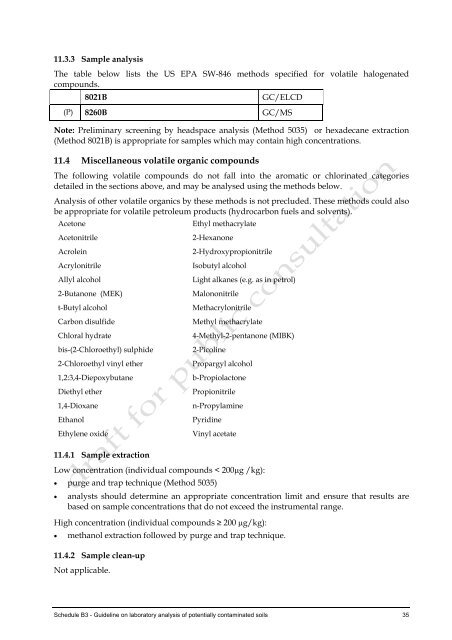Schedule B3 - COAG Standing Council on Environment and Water
Schedule B3 - COAG Standing Council on Environment and Water
Schedule B3 - COAG Standing Council on Environment and Water
- No tags were found...
You also want an ePaper? Increase the reach of your titles
YUMPU automatically turns print PDFs into web optimized ePapers that Google loves.
11.3.3 Sample analysis<br />
The table below lists the US EPA SW-846 methods specified for volatile halogenated<br />
compounds.<br />
8021B<br />
GC/ELCD<br />
(P) 8260B GC/MS<br />
Note: Preliminary screening by headspace analysis (Method 5035) or hexadecane extracti<strong>on</strong><br />
(Method 8021B) is appropriate for samples which may c<strong>on</strong>tain high c<strong>on</strong>centrati<strong>on</strong>s.<br />
11.4 Miscellaneous volatile organic compounds<br />
The following volatile compounds do not fall into the aromatic or chlorinated categories<br />
detailed in the secti<strong>on</strong>s above, <strong>and</strong> may be analysed using the methods below.<br />
Analysis of other volatile organics by these methods is not precluded. These methods could also<br />
be appropriate for volatile petroleum products (hydrocarb<strong>on</strong> fuels <strong>and</strong> solvents).<br />
Acet<strong>on</strong>e<br />
Acet<strong>on</strong>itrile<br />
Acrolein<br />
Acryl<strong>on</strong>itrile<br />
Allyl alcohol<br />
2-Butan<strong>on</strong>e (MEK)<br />
t-Butyl alcohol<br />
Carb<strong>on</strong> disulfide<br />
Chloral hydrate<br />
bis-(2-Chloroethyl) sulphide<br />
2-Chloroethyl vinyl ether<br />
1,2:3,4-Diepoxybutane<br />
Diethyl ether<br />
1,4-Dioxane<br />
Ethanol<br />
Ethylene oxide<br />
11.4.1 Sample extracti<strong>on</strong><br />
Ethyl methacrylate<br />
2-Hexan<strong>on</strong>e<br />
2-Hydroxypropi<strong>on</strong>itrile<br />
Isobutyl alcohol<br />
Light alkanes (e.g. as in petrol)<br />
Mal<strong>on</strong><strong>on</strong>itrile<br />
Methacryl<strong>on</strong>itrile<br />
Methyl methacrylate<br />
4-Methyl-2-pentan<strong>on</strong>e (MIBK)<br />
2-Picoline<br />
Propargyl alcohol<br />
b-Propiolact<strong>on</strong>e<br />
Propi<strong>on</strong>itrile<br />
n-Propylamine<br />
Pyridine<br />
Vinyl acetate<br />
Low c<strong>on</strong>centrati<strong>on</strong> (individual compounds < 200μg /kg):<br />
• purge <strong>and</strong> trap technique (Method 5035)<br />
• analysts should determine an appropriate c<strong>on</strong>centrati<strong>on</strong> limit <strong>and</strong> ensure that results are<br />
based <strong>on</strong> sample c<strong>on</strong>centrati<strong>on</strong>s that do not exceed the instrumental range.<br />
High c<strong>on</strong>centrati<strong>on</strong> (individual compounds ≥ 200 μg/kg):<br />
• methanol extracti<strong>on</strong> followed by purge <strong>and</strong> trap technique.<br />
11.4.2 Sample clean-up<br />
Not applicable.<br />
<str<strong>on</strong>g>Schedule</str<strong>on</strong>g> <str<strong>on</strong>g>B3</str<strong>on</strong>g> - Guideline <strong>on</strong> laboratory analysis of potentially c<strong>on</strong>taminated soils 35
















